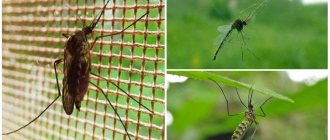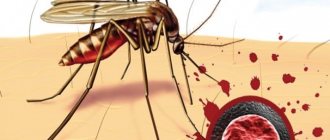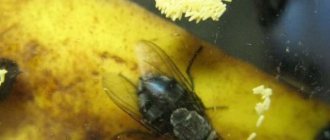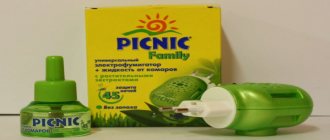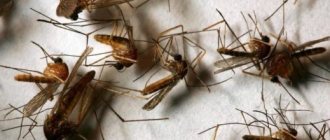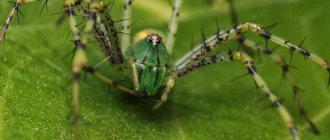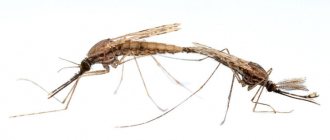Bell mosquitoes
,
chironomids
(Chironomidae) - family of dipterans. The mosquito got its name because of the characteristic sound that is produced due to the fact that the mosquito flaps its wings up to 1000 times per second. Adults do not feed at all, their oral organs are underdeveloped. The larvae of bell mosquitoes (“bloodworms”) live in bottom mud and are capable of living at depths of up to 300 meters. The larvae feed on detritus and microorganisms, some are predators. Bell mosquitoes are harmless to humans. The larvae are used as fish food. Found everywhere, including Antarctica (Belgica antarctica).
Description
Many species of the chironomidae family are often confused with mosquitoes because many of them are very similar to the latter. Jerking mosquitoes have a “humpbacked” body that is black, gray or brown. The larvae of these insects are an important part of the food chains in ponds, streams and lakes.
The lifespan of chironomids is very short. Their eggs are transparent, females lay them in large groups in the water. The larvae hatch after 3 days and are white, red or green in color. Externally, the larvae resemble small worms with a dark head. These larvae fall to the bottom and feed on algae and other microorganisms.
After about 4 weeks, the larvae are ready to turn into pupa. The larvae remain in the pupal stage for 48 hours, after which adults hatch. Adults live 5-10 days and do nothing other than mate and lay eggs.
These insects do not bite, but can be very annoying due to the fact that they swarm in large numbers. Bell mosquitoes are most active at night, appearing just after sunset. Swarms of these insects can produce a loud buzzing sound that can be heard over very long distances.
What attracts mosquitoes? They fly towards the light and usually swarm around street lamps at night in the summer.
Appearance
The bell ringer, the bell ringer, the jerk - the mosquito received all the names due to certain features. Males gather in flocks and quickly flap their wings to attract females. The result is a ringing sound that females can hear several tens of meters away. The insect has three pairs of legs, but does not use the front ones for support. The paws are directed upward and do not support the body; as a result, the abdomen constantly twitches to the sides.
Most species are green mosquitoes, but there are dark brown, brown, reddish, and gray colors. In Antarctica, bells are dark in color, which does not reflect the sun's rays, and without wings. All the rest look like ordinary squeakers. The body size does not exceed 1 cm. A photo of the bell-bellied mosquito is presented below. Males are somewhat larger and have fluffy mustaches.
Interesting!
In the mosquito family, there are always more males than females.
Life cycle and other features
The ringing mosquito bothers you with its squeaks - this is its key harmfulness
Chironomids are divided into 3000 species. The life cycle of this insect is very short, only 7 days, in some species it is 3 days. Outwardly, they are not very noticeable, colored dark brown or yellowish-green. Why were they called bells? It turns out that males gather in huge flocks and soar in the air, emitting a specific ringing sound to attract a female. The female, having heard their call, following her instincts, flies into a huge flock of males. In just a couple of seconds, she flies out fertilized.
The second name is jerk mosquitoes, they received due to the peculiarity of landing on the surface. These insects rely only on the back and middle pair of legs. The forelimbs are always raised, so the body of the insect is continuously supported. This position of the body is due to the fact that they detect the approach of danger.
Up to 9 mm long, hairy green bells are larger than the common mosquito. Chironomids lay their eggs in mud, and the future offspring are covered in a common gelatinous transparent shell. The type of insect can be determined by the shape and location of the eggs. After some time, transparent larvae 25-30 mm long will emerge from the eggs. Repeatedly moulting, they acquire a scarlet color. This is due to the presence of hemoglobin in the hemolymph. Thanks to this, the red larvae of the mosquito mosquito can live in places where there is no oxygen. People call them bloodworms.
Mature larvae form pupa with tracheal gills on the muddy bottom of ponds or other bodies of water. As a result of metamorphosis, small green mosquitoes are formed inside the motionless pupae. Insects are released from the pupa using air. The capsule seems to be torn apart by the overflowing air.
Story
Chironomids have a long phylogenetic history. In the Upper Jurassic, Chironomidae from the subfamilies Podonominae and Tanypodinae—benthic algophagous scrapers—were already numerous. Aquatic dipterans appeared later than many aquatic insects and had to integrate into already existing communities. The appearance of filter feeders of the subfamily Chironominae is associated with the eutrophication of water bodies. It is the pelophiles of this subfamily that are most richly represented in modern lakes. Thus, it was Chironomidae that reached the highest level in the adaptation of larvae to respiration in an aquatic environment. They mastered lotic and lentic systems, deep and shallow, temporary and permanent, freshwater and hyperhaline reservoirs, rich and poor in oxygen, cold and warm waters, as well as peripheral parts of the ocean and some terrestrial habitats with high humidity. They have also successfully adapted to wide gradients of temperature, pH, salinity, oxygen content, flow speed and pollution. In many aquatic ecosystems, up to 50% of macroinvertebrate species are Chironomidae [6] . Changes in the abundance of chironomids in bottom biocenoses of water bodies are associated with their transition from the preimaginal stage to the imaginal stage, that is, with a heterotopic (aerial) way of life.
Egg laying is of no small importance in the settlement of chironomid larvae. Some researchers believe that female chironomids lay eggs in places where pupal exuviae accumulate, that is, where there is a massive emergence of mosquitoes and the occupied niche becomes temporarily vacant. According to others, the selected area for laying eggs is the habitat of the larvae, where their development occurs. However, the choice of oviposition sites by females may depend on the conditions necessary for the embryonic development of insects [9] . Therefore, females of the rheophilic faunal complex lay attached clutches on the hard substrate of the shores; embryonic development proceeds under humid conditions, and not in water. And the females of the limnophilic faunal complex lay unattached clutches that sink into the bottom layers, therefore, embryonic development occurs in the aquatic environment. Chironomid larvae can penetrate both from rivers into lakes and from lakes into rivers.
Polypedilum vanderplanki larvae are the most complex organisms known to tolerate desiccation [10] . As part of the Biorisk space experiment, the dried larvae spent more than a year in outer space on the outside of the ISS [11], with more than 80% of the larvae surviving.
Taxonomy
The systematics of chironomids is currently an intensively developing field of entomology. Recently, it has received a new impetus in development after the introduction of karyosystematics methods and the discovery of twin species that differ well in karyotypes and poorly in morphology. If earlier the taxonomy of chironomids was complicated by the fragmentation of identification systems for the preimaginal stages of development, studied by hydrobiologists, and the imaginal stages, studied by entomologists, now the problem is the comparison of data from taxonomists-morphologists and taxonomists-cytologists [12].
Lifestyle of the bell mosquito
Green small insects do not pose a danger to humans. Adults have underdeveloped mouthparts and do not feed at all. They live no longer than 1 week. The main purpose is to reproduce offspring.
Green bell mosquitoes are active in early spring, when temperatures rise to +12 degrees Celsius. Males gather in flocks, attract females, and mating occurs. Females become sexually mature 20 hours after birth. The mass flight occurs at the end of May and continues throughout June.
At one time, green mosquitoes lay from 900 to 1500 eggs. They are enclosed in a kind of bag with a tourniquet at the end. The female dumps her eggs into the pond. The bag is attached to plants and damp soil. Embryonic development lasts 6 days.
At a temperature of about 20 degrees Celsius, the first mosquito larvae hatch after 60 hours. Mass birth occurs after 140 hours. With increasing water temperature, the duration of development is reduced, but the probability of death increases. Under natural unfavorable conditions, 98% of the population dies.
On a note!
After laying eggs, the female dies, her life expectancy is on average 5 days, males live less. Under favorable conditions, 6 generations of green mosquitoes appear over the entire warm season.
Mosquito repellents
Despite the fact that green mosquitoes do not feed on blood and, unlike ordinary mosquitoes, are not carriers of diseases, they can cause allergies. In addition, the ringing noise they make interferes with normal rest. To prevent the appearance of green mosquitoes in the apartment use:
- Mosquito nets;
- fumigators;
- ultrasonic repellers;
- lamps and insect traps.
A mosquito net protects against insects that enter the room from the external environment, but it is not effective in combating mosquitoes that are already in the apartment or fly in from the basement.
Fumigators - Chemicals released into the air when the fumigator is heated destroy the nervous system of the mosquito, as a result of which it loses the ability to fly and dies.
Ultrasonic repellers - repel mosquitoes using high-frequency sound waves, but do not kill insects. At the same time, they are harmless to others and pets.
Ultraviolet lamps attract mosquitoes, they fly into the light and die when they come across an energized mesh.
Development
Bell bell larvae live in silt near ponds and large puddles. Once born, they remain in the mucous membrane of the pouch for 20 hours. After this, development continues in the mud.
Initially, the worm-like larvae are colorless, body length no more than 1 mm. Gradually acquire a dark color. In an oxygen-deficient environment, bloodworms turn red. For movement, a soft, liquid soil substance is required. Baby green bells live near the shores of reservoirs with fresh and salt water. They have the ability to go deep up to 400 cm from the soil surface.
Green mosquito larvae are complex organisms that can withstand low and high temperatures. Young offspring overwinter in water at a temperature of 0 ° C, and with a lack of oxygen they fall into suspended animation. Pupae can withstand temperatures above 35 °C. When dried, they continue to show signs of life, and with the onset of favorable conditions, they continue to develop.
Interesting!
As part of the experiment, green bell larvae were left on the outside of the ISS in outer space. They remained in this state for more than a year; about 80% of the individuals survived.
During the entire development cycle, mosquito offspring go through up to 5 molts and constantly increase in size. At the end of the cycle, pupation occurs. The pupa is about 3 mm in size, mobile, dark in color. After 3 days, the imago is born. Full development of the imago takes place in 20 days under favorable conditions.
Meaning for humans
The waste products of the larvae of bell mosquitoes, which mature in the estuaries of the Azov Sea, form medicinal mud at the bottom, and therefore in 2007 a monument to the bell mosquito was erected in Berdyansk.
Benefits and harms
The mosquito does not cause any harm to humans. Since he has an underdeveloped mouthparts, he cannot bite. These insects cause inconvenience if their numbers are huge. When meeting a person, they try to explore him, so they penetrate the ears, nose or eyes. People who live in the Azov region suffer the most from these pests. This region has huge populations. This is due to the fact that in the Azov region there are many reservoirs and estuaries.
Although mosquitoes can cause some harm, they can also be used for good. Experienced aquarists use chironomid larvae to feed aquarium fish. Worms are rich in nutrients, so they are consumed by reptiles and some types of birds. Bloodworm is also popular among fishermen.
On the territory of Berdyansk (Ukraine), residents erected a monument to Chironomidae. This is because the Dergun people take an active part in restoring and saturating the healing mud. It is prohibited to catch or destroy bells.
Difficulties associated with large populations of chironomids are rare. After all, many factors influence the lifespan of insects. If the climate in the region is warm and humid, then the number of bells increases rapidly. Sudden temperature changes cause green mosquitoes to remain in the larval stage for much longer.
To protect themselves from these pests, people use a variety of devices and means. And the following are especially popular:
- Mosquito nets. They are used for window and door openings by those people who live near ponds and swamps. If the cell size is chosen correctly, chironomids are not able to penetrate through the artificially created barrier.
- Essential oils and certain extracts. Since bells do not tolerate rich aromas well, lavender or citrus oils can be used for protection. They are applied to exposed skin.
- Aerosol preparations. Aerosols designed to protect against pests are also suitable for protection. They contain components that repel or destroy insects.
- Various devices. To prevent contact between chironomids and a small child, you can use special bracelets or buttons. They are presented in a huge range, so choosing the appropriate device is easy.
Green mosquitoes are harmless insects that do not harm people or animals. They bring a lot of benefits because they act as food for fish and small animals.
Bell mosquitoes and bloodworms
This article will focus on the bell mosquito. Few people have heard of him. Unlike blood-sucking mosquitoes, bells do not annoy people, so they, accordingly, do not care about them. Unless scientists, due to their curiosity, try to understand their private lives. But their children, the bloodworms, are much better known. Everyone knows bloodworms, especially those who deal with aquarium fish or winter fishing with a fishing rod.
Zvontsov can be observed on quiet and warm evenings near bodies of water starting in mid-summer. This is an unforgettable sight. Huge hordes of mosquitoes “hustle” in the air, making ringing and buzzing sounds. This is where their name comes from.
I was once walking along the shore of the reservoir and heard a roar. There was a high-voltage line nearby, and it seemed as if the wires were making this characteristic sound. However, upon closer inspection, I saw mosquitoes in the air. There were a great many of them. They either gathered into a huge swarm, or disappeared into the air. If you try to compare what you see with something ordinary, then all this most likely resembles puffs of smoke. Having huddled into a dense ball and changing shape every second, these “puffs of smoke” move in the air. So I stood for several hours, admiring this magnificent spectacle.
It was already getting dark, however, despite this, swallows and swifts continued to rush among the swarming mosquitoes. How could they miss the opportunity to enjoy such delicious food, especially since catching it was not difficult. Open your mouth wider and have time to swallow. It’s impossible to count how many of them ended up in the stomachs of birds and their chicks!
In the morning the ground was strewn with mosquitoes. A huge number of them are caught in the web. What joy for their owners! The spiders gorged themselves on such abundant food. While dealing with mosquitoes, they probably gloated, remembering the insult inflicted on one of their ancestors in the episode with the “clattering fly.”
I took a closer look. All the dead mosquitoes had bushy mustaches, like grenadiers. These were males. They fulfilled the function of procreation assigned to them by nature and died. This is not surprising, since ringing mosquitoes do not live long, from several hours to 3-7 days. Males die immediately, and females die later, after they lay eggs in the water.
There are about 10 thousand species of bell mosquitoes, in Russia there are a little more than 400. Their size, depending on the species, varies from 2 to 6 mm. Adult mosquitoes don't eat anything, they don't even have a mouth. They live off the reserves accumulated during the larval period. That's why they have such a short lifespan. These reserves are only enough to mate, find a suitable body of water and lay eggs in it. The life of adults is short, which is why they have such a coordinated emergence. Myriads of insects simultaneously leave the pond to take part in “mating dances,” lay eggs, and then go to another world.
The eggs hatch into larvae that feed, grow, and then, on some command, turn into mosquitoes and see their native body of water from a bird's eye view. By the way, scientists have calculated that in the taiga and forest zones there are so many mosquitoes that when they die off, they introduce into the soil a significant amount of microelements that are so necessary for the life of plants.
We encounter mosquito larvae much more often than adult insects. We know them as “bloodworms”, and specialists call them “chironomids”. However, this is only a small group of bell mosquitoes among their huge diversity.
Bell bell larvae live mainly in fresh water bodies, preferring standing and slowly flowing ones. Some of them live in the coastal zone of the seas. By the way, they are one of the few insects that have adapted to live in the marine environment. There are species that develop in damp soil. So this large group of mosquitoes takes advantage of ample opportunities for their development.
Mosquito larvae (we will further call them bloodworms) live in silt, and develop there in huge quantities. Thus, from one square meter of sludge from reservoirs polluted with organic matter, up to a kilogram of bloodworms can be washed. Mosquito larvae, like earthworms, pass silt through the intestines, while digesting everything edible there - bacteria, algae, protozoa. At first glance it seems that sludge is a low-calorie product. In fact, they are rich in organisms, which these red “worms” digest. Thus, one gram of sludge contains several billion bacterial cells. And how many protozoa and algae there are – you can’t count them! By eating all these living creatures, mosquito larvae help cleanse water bodies. After all, in just one day they eat food several times more than their own weight. On such good food, the larvae grow quickly and reach 25 millimeters. They then pupate and turn into insects.
Depending on the habitat, the color of the bloodworm varies from pale pink to dark red. This is due to the amount of hemoglobin in their body. When the oxygen concentration in the environment is low, the amount of hemoglobin is higher. Accordingly, the bloodworm has a darker color.
Mosquitoes quickly colonize any body of water, regardless of size, depth, degree of pollution, including newly formed ones. Due to their high numbers, bloodworms are an important part of benthic organisms. It is well eaten by many fish and is their main food.
Bloodworms are also useful because they are used as food for aquarium fish, ornamental animals, and birds kept at home. For this purpose, bloodworms are obtained from reservoirs. The sludge is washed by passing through special sieves, where it ends. They are stored in the refrigerator, where they remain alive for quite a long time. Bloodworms are also used as a laboratory animal in scientific research - genetic, physiological, toxicological.
So modest and inconspicuous parents have such important and famous children.
When implementing the project, funds from state support were used, allocated as a grant in accordance with the order of the President of the Russian Federation dated March 29, 2013 No. 115-rp) and on the basis of a competition held by the Knowledge Society of Russia.
A.P. Sadchikov
professor at Moscow State University M.V. Lomonosov
Moscow Society of Natural Scientists
Material in sections:
- In the world
- Environmental education
Meaning in nature
Green bells are harmless creatures, unlike other types of mosquitoes, they do not pose a danger to humans or farmland, but are important in nature. Adults do not feed at all; larvae feed on microorganisms in liquid sludge. Bloodworms act as food for fish, crustaceans, beetles, spiders, other insects, birds, and reptiles.
Green bell larvae are specially bred for aquarium fish. To get ready-made food, scoop up the sludge and pass it through a sieve. The larvae contain a huge amount of protein and amino acids necessary for the full development of fish.
Interesting!
A monument to the green bell-bellied mosquito has been erected in Berdyansk.
:
What danger do mosquitoes pose to people?
Many people are afraid of blood-sucking mosquitoes (they are also called squeakers), since they can pose a danger to animals/humans due to the risk of transmitting a variety of infectious diseases, among which the most common are encephalitis and meningitis.
Young children can scratch the bite site until it bleeds, which can lead to streptoderma. Because of this, it is recommended to think in advance about the availability of protective equipment, especially if you plan to rest in the forest, near water bodies.
But it is important to know that green bell mosquitoes do not pose a danger to either a child or an adult, since they cannot bite and, therefore, infect one or another infection. And the bloodworms of the bell mosquito are an indispensable food for fish.
Reproduction
These insects swarm in very large numbers for mating. Female chironomids then lay their eggs in water, on aquatic plants, or in moist soil near water sources.
Since the life cycle of bell mosquitoes is quite short, about a month, up to 5 generations of these insects reproduce over the summer. Of course, the number of generations depends on the temperature and humidity at the breeding site.
Life cycle of chironomids
During their life, these insects go through 4 stages of development: egg, larva, pupa and adult. First, the female lays her “gelatinous” eggs on the surface of the water (up to 3000 at a time). After a few days (up to 7 days), the eggs sink to the bottom and hatch there. The larvae leave the eggs and burrow into the mud. They use dirt and organic remains at the bottom as food. During development, the larvae acquire a brighter color. The larval stage lasts 2-7 weeks, depending on the water temperature, after which the larvae turn into pupa. This stage lasts up to 3 days. The pupae actively rise to the surface; a few hours after this, the imago emerges from the pupa. After emerging from the pupa, the imago begins to look for a pair to mate with. Adults only live 3-5 days because they do not eat anything after they reach sexual maturity. During the summer months, the mosquito breeding cycle lasts 2-3 weeks. In autumn and winter, the larvae cannot pupate. But in the spring (late March or early April) they immediately pupate, and after that adults appear almost immediately.
Favorite breeding sites
In natural and man-made water sources, chironomids are the main inhabitants. The favorite breeding grounds for these insects include any amount of water. Examples include lakes, settling ponds, water oxidation ponds, domestic lakes and ponds, and slow-moving small rivers. If there are enough nutrients in the water, up to 4000 larvae can be found on one half meter of the bottom. During the summer, it is quite common for thousands of adults to be born for every square meter of water surface at night. Such a number of bell mosquitoes can even lead to economic problems.
Life cycle of green mosquitoes
Bells are insects with a full cycle of transformation. The fertilized female lays eggs on the water surface or leaves of plants growing near the water. After a few days they sink to the bottom or fall into moist soil.
Bell bell larvae are gray in color. After hatching from the eggs, they burrow into the mud and spend two to seven weeks there. During this period, future insects feed on soil particles and remnants of organic compounds found in the ground or at the bottom of the reservoir. During this time, the color of the larvae changes and by the time of pupation they become bright red.
Green mosquito pupae have tracheal gills. After they rise to the surface, the cocoon with the formed imago bursts under the pressure of the air collected inside the capsule.
The appearance and color of the adult depends on the insect's habitat. Female bells die immediately after laying eggs. Males live a little longer, but since they are deprived of the opportunity to consume any food, the average life cycle of adult insects does not exceed one week.
Peculiarities
The body color of the mosquito is green or yellow-gray. The length of its body is 9–10 mm. These insects are hardy, so they are found in many countries. Some subspecies live in Antarctica. They are not afraid of severe frosts or heat. Residents of Antarctica are distinguished by their dark color, which eliminates the possibility of death in severe frosts. They are classified as wingless.
In the scientific literature, green mosquitoes are called chironomids or jerks. The main reason is behavioral patterns. After all, insects do not use their forelimbs to maintain balance, so their body periodically twitches.
Life cycle
Twitch mosquitoes have a short life cycle. These insects spend the maximum amount of time in the larval stage. After pupation and transformation into adults, they live for about 2–5 days. The larvae of this insect are characterized by increased activity. They settle in various places:
- In reservoirs.
- On fruit and wild trees.
- In silt or wet soil.
- In manure.
As food, the larvae use filtrate, which is formed by silt vegetation, as well as microorganisms present in the soil. Adult green mosquitoes form a clutch of eggs all once, after which they die immediately. For laying, pests select those places where there is a wet substrate or silt. To protect the eggs, a peculiar gelatinous substance is used that covers them. Entomologists use this feature to distinguish a clutch of chironomids.
The hue of the emerging larvae is deep red. After all, their body is saturated with hemoglobin. The presence of a large amount of hemoglobin allows the bell mosquito larvae to survive even if the amount of oxygen is minimal. To ensure the survivability of the worms, they were sent into space. More than 75% of the insects survived.
Some male jerks lived and developed for 1.5-2 years. Although this phenomenon does not happen often. More often, chironomids die after growing up in 2–5 days. The main reason is the lack of a well-developed oral apparatus. After all, this does not allow them to receive the amount of food required to maintain all life processes. Adults feed on nectar or plant sap. But this also requires them a lot of strength.
Mosquitoes (bloodworms)
The mosquito (Chironomus) belongs to the order Diptera, being a member of the species-rich family of chironomids (Chironomidae, or Tendipedfdae).
Everyone knows these large mosquitoes with long legs that fly in large swarms and swarm in the evening air on quiet summer evenings. Interestingly, these swarms consist almost exclusively of males. Sitting down on some surface, the mosquito extends its front legs and, remaining in this position, constantly twitches them (hence the name). These mosquitoes are completely harmless to people and animals; they do not have the ability to bite. On the contrary, they have an unconditionally positive significance, since their larvae, multiplying in masses, serve as the favorite food of fish.
Everyone who is interested in aquarium business knows, of course, red worms, which are used as food for aquarium animals and are collectively called bloodworms. These are nothing more than the larvae of the jerk, which you constantly encounter on a freshwater excursion.
These larvae live in calm bodies of water with a muddy bottom: ponds, lakes, ditches, etc. To detect bloodworms, it is best to grab a little silt from the bottom of the reservoir where it lives and wash the latter in water. Then we will see in front of us bright ruby red or greenish worms up to l.5 cm long, with a clearly dissected body.
Larvae of mosquito mosquitoes, or chironomids (Chironomidae). Increased 1 — larva of the pusher mosquito (Tanypus monilis); 2 — larva of a pusher mosquito of another species (T. varlus); 3 — larva of the mosquito (bloodworm) (Chironomus plumosus); 4 — larva of the bearded mosquito (Ceratopogon); nn - false legs.
Movements. Throw such a larva into a vessel of water, and you will become familiar with its methods of movement. In the water, the bloodworm swims with the help of sharp snake-like movements, bending its body first in one direction or the other like a figure eight (“dangling” - in the popular expression, hence the name). Having dropped to the bottom, the larva begins to slowly crawl, clinging to surrounding objects with its false legs, of which it has two pairs - one at the front, the other at the rear end of the body.
The bloodworm breathes through the entire surface of its body. But in addition, at the rear end of the body it has special respiratory organs, in the form of thread-like gill appendages. Being in a calm state, the larva makes characteristic wave-like movements with its whole body, thereby causing a change in the water around it. The striking unusually bright color of the larvae depends on the color of their blood, in which hemoglobin is dissolved - a phenomenon very rare in insects. This red pigment has the ability to absorb oxygen, chemically binding it. Thus, the larva has a supply of oxygen in its body, which it can gradually consume. In all likelihood, this circumstance is the reason for the extreme vitality of bloodworm larvae, which are able to live for a long time in heavily polluted water.
The larvae feed on various plant and animal remains, which they find while rummaging in the mud.
Part of a leaf cutter (Stratiotes) with leaf-mining larvae of the mosquito. Eating. led
Lifestyle. Leading a bottom lifestyle, bloodworms huddle in muddy tubes, which are arranged by larvae at the bottom of reservoirs. When building tubes, the larvae glue particles of sludge together with secretions of their salivary glands. When pulling out various underwater objects (stones, sunken poles, etc.) from the bottom of the pond, you can often see such tubes completely dotting their surface. Each larva sits in its own tube, like in a muff, sticking out its head end, with which it digs in the silt.
There are species of jerks, the larvae of which build their tubes from plant debris, just as the larvae of caddisflies and aquatic butterflies do. There are also chironomids that find shelter by boring through plants and climbing inside plant tissue. These are the so-called “mining larvae”, which are not difficult to detect when examining the light and loosening the leaves and stems of various underwater plants: teloreza, chastukha, cattail, pondweed, etc.
Finally, there are bloodworm larvae that drill their passages in colonies of bryozoans and sponges.
Reproduction. Derguns lay their eggs in water, encasing them in a gelatinous transparent substance. These tiny jelly-like formations, with yellow, brown or black oblong eggs visible in them, have different shapes in different types of jerks: a rounded lump, an oblong sausage with a spiral arrangement of eggs, a long double cord that is attached to the substrate, etc. From The eggs hatch into larvae that are grayish or colorless until the first molt, and then acquire a red or greenish color. Mature larvae pupate at the bottom of the reservoir in silt tubes. In appearance, the twitch pupa differs in many respects from the pupae of other mosquitoes. It has tracheal gills, which sit on the front of the body in the form of a pair of bush-like branched tufts. Such a pupa never swims freely and does not rise to the surface of the water, resting motionless inside its silt tube, from which only its gills are exposed. This is the reason why these pupae are encountered much less frequently on excursions than the mobile pupae of other mosquitoes.
Egg laying in various mosquitoes (Chironomus). Zoomed in, nearby masonry is drawn. led
When the time comes for hatching, the body of the pupa is filled with air and is quickly pushed to the surface of the reservoir, where its covers burst, releasing the winged insect.
Along with the bloodworm larvae, larvae of many other representatives of the chironomid family are often found in fresh waters. They are extremely common everywhere and are truly ubiquitous. In river silt, in the beds of mountain streams, on the rocks of waterfalls, in bright springs, in the stinking mud of stagnant waters, in which animal life has almost disappeared - everywhere we will meet chironomids, partly crawling freely, partly hiding in one or another shelter. Sometimes these larvae overwinter by freezing into the ice. Of these numerous forms we will note only two genera.
Pusher mosquito (Tanypus). The larvae of this mosquito in all respects resemble the larvae of the twitch, with the only difference being that they have much more developed false legs, which help them climb among dense plant growths, where they usually stay, making tunnels for themselves. The larvae are colored light red. The egg clutch of the pusher has the form of a small gelatinous lump filled with eggs, which the female lays in the water.
The bearded mosquito (Ceratopogon) has a thin, long, colorless larva with a clearly articulated body, which bears a star-shaped corolla of hairs at the posterior end of the body. The larva lives among underwater thickets and swims deftly, bending its body in an S-shape like a tiny transparent snake or roundworm.
